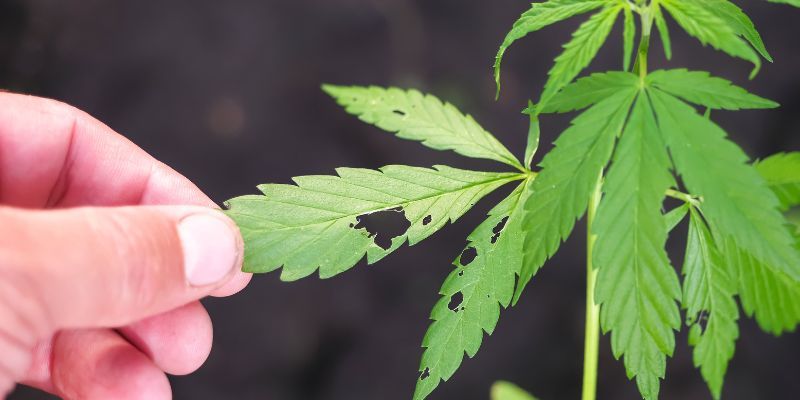
Common Pests of Cannabis
Cannabis plants can be ruined by common pests that have the ability to completely decimate an entire garden or crop if left untreated. No matter how much you’ve invested in your grow room with quality lights and even if you’re using the best cannabis seeds, plants can be annihilated by pests and diseases that get a grip on your crop.
Common Cannabis Pests
It is critical to understand the damage these pests can do and treat them quickly. You can even implement some preventive strategies to help avoid a problem altogether. Keeping your grow area clean and tidy and never introducing outside tools or clothing can help to keep your room free from pests. Most commercial grow operations make handlers change their clothes and shoes before entering the grow space. If growing outdoors, you can put some netting around your plants to prevent some pests, like grasshoppers, and you can introduce predatory pests, like ladybugs, to ward off disaster-causing pests.
[maxbutton id=”2″ text=” Get Pest Resistant Beans url=”https://seedcellar2.wpenginepowered.com/product-tag/pest-resistant-cannabis-seeds/”]
Some of the most common pests of cannabis plants include:
Cannabis aphids – these insects suck fluid from cannabis leaves and can be a serious nuisance to both indoor and outdoor crops. Aphids can be many different sizes depending on their maturity level and age and are often seen on the underside of leaves. Aphids will expand quickly if left unchecked and leave a sticky mess on cannabis plants that will reduce the quality and quantity of your harvest.
Aphid predators like Ladybugs, also called Ladybirds, which are a Coccinellidae beetle, are natural predators of aphids and can help control and prevent an infestation when introduced to your plants. Soap-based sprays are also useful to treat aphid activity.
Broad mites – broad mites are very small, .2 mm or less, which is about half the size of a spider mite. This makes them virtually impossible to see with the naked eye and even difficult with a magnifying glass. Broad mites make leaves appear droopy, blistered, twisted, glossy, and unhealthy. Many growers mistake a broad mite infestation for nutrient problems, heat stress, or a pH issue, which makes treatment even more difficult.
Many growers use soap sprays or Neem oil rather than chemical sprays. Natural predators are Neoseiulus, which can help control mites.
Spider mites – spider mites are difficult to see as they are also quite small and leave tiny white specks all over your leaves. Check the underside of your leaves and control quickly with Neem oil, soapy spray, or natural predators.
Russet mites – russet mites are difficult to see without a magnifying glass and usually live in the crevices of stems, buds, or leaves. They usually start at the base of the plant and will move to the flowers if allowed. They often move around by attaching themselves to clothing or other pests like whiteflies and aphids. Proper sanitation is critical, and one of the best methods to get rid of russet mites is with micronized sulfur diluted in water and applied with a sprayer. Severely infected plants should be destroyed.
Caterpillars and inchworms – the main symptom most growers realize when caterpillars and worms infect their plants are holes in the leaves. They munch right through the plant leaves and leave black specks, droppings on your leaves, which is an indication that you have a Caterpillar infestation. There are anti-caterpillar sprays, but many growers prefer to remove them by hand to maintain organic growth.
Grasshoppers – grasshoppers might seem harmless, but they very much enjoy eating your cannabis leaves. They can be removed by hand and can often be prevented by setting up netting around your plants.
Crickets – there are two types of crickets that commonly infest cannabis plants. The typical cricket will chew on your leaves, while mole crickets will tunnel underneath your plants and disrupt the roots just like moles.
Thrips – thrips leave trails on your leaves that look like snail trails of dried-up spit. They cause problems that can be mistaken for environmental stress or nutrient deficiency. They are very small, squirmy, fat worms that live on the cannabis leaves.
Whiteflies – also called the white fly, these pests often hang out underneath the cannabis leaves and look like tiny little white moths.
Fungus gnats – fungus gnats appear around the soil when it stays wet for long periods of time and leave a wormlike larva that crawls around the top of wet soil. They look like dark flies, and plants will start to appear sick with a fungus gnat infestation. Soils that contain woodchips can be prone to fungus gnats, and many growers prefer to buy wood-free soil to mitigate the risk of fungus gnats, which can damage the root system and stunt plant growth.
UVB lighting is shown to have a destructive effect on gnats and other insect pests as well. Diatomaceous earth can act as a barrier to prevent the larva from emerging through the soil.
Neem oil is a common treatment for many pests as well as fungus and mold, and is completely organic and safe. Many growers mix with water as directed, and it typically puts off an earthy kind of garlicky smell. As with any type of pesticide, try to avoid spraying on the flowers to not affect the final smell and taste of your buds.
Inspect your plants regularly, follow preventive measures, and treat any infestation quickly. Always start your grow with high-quality cannabis seeds you can find at The Seed Cellar. Check out one of the largest selections of quality cannabis seeds, including regular, auto-flowers, and feminized seeds.

